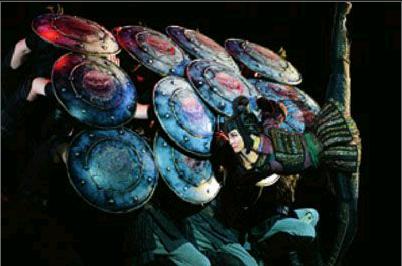Legend of Mulan
2015-05-22ByCorrieDosh
By+Corrie+Dosh

With themes of strength and femininity, filial piety and honor, the legendary Ballad of Mulan has inspired generations of young Chinese students who dutifully recite the 5th-century tale as part of their standard school curriculum. After the release of the 1998 Disney adaptation, millions more children around the world became acquainted with the tale of the maiden who disguises herself as a man to take her ailing fathers place in the emperors army. Its a story that thrills in any medium, and now as a four-act dance—presented by the Hong Kong Dance Co. in residence at the David H. Koch Theater in New York City in March.
An eclectic crowd of diverse nationalities and ages packed the theater to see the performance choreographed and directed by Yang Yuntao and starring the luminous Pan Lingjuan as the warrior princess. We first meet Mulan attired in a gauzy white dress, distraught over the conscription of her father into the forces marching to war. In a clever flashback, we see young Mulan practicing martial arts with her father as her present-day counterpart realizes that she must take his place in the battle.
“Ive never seen a flashback done that way before in dance. I loved it! It was really interesting and I understood right away what they were trying to say without any words,” said Michael Toy, who had come to see the performance with his wife and young daughter.
A faithful version
Conveying the emotional tale of Mulan—though a familiar story to American audiences—without words was a challenge, said Pan.
“I think human nature is interlinked,” she said. “I have watched a lot of foreign movies, and I am deeply moved by some of them. No words are necessary for emotional resonance—that is why dance drama can exist.”
With so many familiar portrayals of the warrior maiden, Pan said she “just wanted to be herself” and drew inspiration from her own childhood.
“My father is a military officer and I grew up in a military families compound. It affects my performance in that, although I am a female dancer, I feel more confident to act as a man brandishing the club on the battlefield than to act as a girl spinning and weaving at home,” she said.
Indeed, the strongest moments of the performance are the military battles. Pan skillfully spins and twirls a bo staff to show the characters martial arts skills and leads her forces in a thrilling sequence featuring a large ramp the cast runs up and slides down in their attempts to storm the enemy gates.

“The most difficult part is the staff play. Staff play does not belong to dance movements and it is hard to control. The other challenge is the inner emotion of the role,” Pan said. “I want to show two extreme emotions in front of the audiences. Fear and worry in the beginning and[Mulans] courage and bravery in the end. The role of Mulan describes the power of filial piety.”
It is the universal power of family love that prompted artistic director Yang to stage the dance drama for an American audience.
“The most important message the story conveys is filial piety and affection between family members,” Yang said. “Regardless of differences, Eastern and Western audiencesunderstandings of filial piety are similar. More importantly, the story contains the message of self-identification, which I think would be more recognizable to Western values. This theme could let Western values and Eastern values merge here rather than conflict.”
Ballad of Mulan is a traditional Chinese folktale that is familiar to most Americans, Yang said, yet many do not know that it is a traditional poem recited by Chinese schoolchildren. Yangs version is faithful to the original verses, without the romance storyline added by Disney or other additions.
“In this form, as a dance drama, the legend of Mulan is totally different from other versions like movies or TV series. In regard to content, our dance drama is the closest to Mulans poem Ballad of Mulan, as we all know the original poem has only some 300 characters and it is impossible to create a long work from a short poem. So other adaptations or arrangements usually add a lot of imaginative input from producers,” he said.
Yang also opens his performance with the sound of schoolchildren reciting the original verses.
Wilson Fung, Vice Chairman of the Hong Kong Dance Co., said the New York performance was part of the troupes international mission.
“We bring our citys unique artistic style to the world by visiting different locations with our original products, engaging audiences to encourage cultural exchange,” Fung said. “We have done this as a prelude before, during our performances in Hong Kong, and it has been fantastic. So we would love to continue this tradition in North America as well.”
More highlights
Another highlight from the performance was the costume designs from Karin Chiu, an award-winning costume designer known for her blending of Chinese and Western aesthetics. Audience members were given the chance to examine her designs closer during intermission at a display in the lobby. An ethereal blue gown of chiffon featuring hand-painted flower appliques delighted two young girls, who excitedly proclaimed it “so beautiful.” The feminine gown was a stark contrast to the costume for Mulan as the military general, featuring plastic trimming and a chain mail of metallic threads. Yet even the masculine armor had a touch of femininity with layers of fabric added under the plates.
The multilayered set was excellent, giving the dancers multiple surfaces and levels from which to portray the tale. Mountains and city walls were abstract but clear in their intent. The lighting was also excellent, including that in a lantern dance that was beautiful and haunting.
The score was beautiful, but the recording used in the performance, however, was decidedly lacking. At times the music would go silent, leaving the audience to wonder if it was a planned pause or if the audio track had simply chipped out. The recording was flat and harsh. A live accompaniment would obviously have been a great improvement.
The Hong Kong Dance Co. was established in 1981 and incorporated in 2001 as a charitable and non-profit artistic institution. The troupe has staged over 100 productions including a 2013 tour of Qingming Riverside in Toronto and Washington, D.C. The group has also been invited to perform at the “Meet in Beijing 2008” Arts Festival at the Olympic Games and at the opening ceremony of the 2009 East Asian Games. It was honored with the 2013 Hong Kong Dance Award for Outstanding Achievement in Production for its performance of Spring Ritual·Eulogy.
The Mulan performance was sponsored by the China Arts and Entertainment Group(CAEG), its fourth production at the David H. Koch Theater at the Lincoln Center for the Performing Arts since The Peony Pavilion in January 2012. CAEGs two core companies China Performing Arts Agency and China International Exhibition Agency have organized thousands of governmental cultural exchange projects and commercial stage performances and arts exhibitions both at home and abroad.
